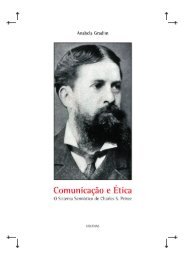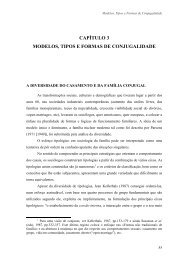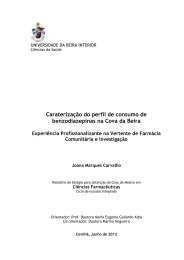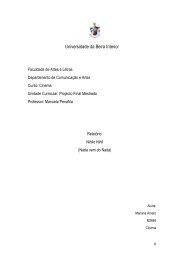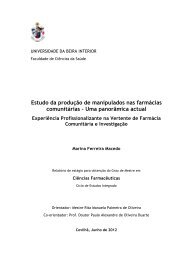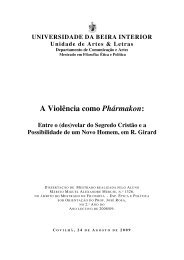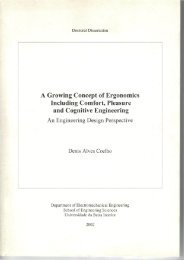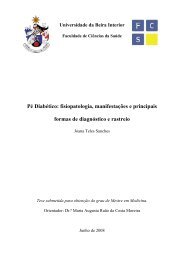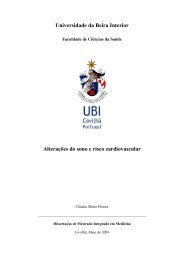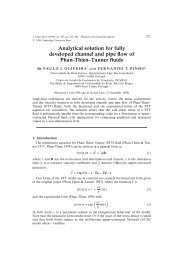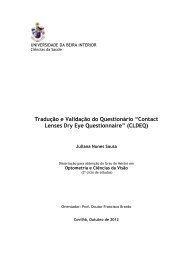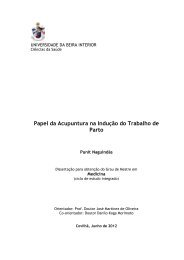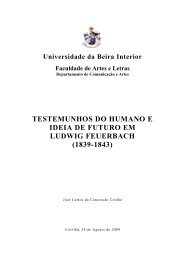Tese_Tânia Vieira.pdf - Ubi Thesis
Tese_Tânia Vieira.pdf - Ubi Thesis
Tese_Tânia Vieira.pdf - Ubi Thesis
Create successful ePaper yourself
Turn your PDF publications into a flip-book with our unique Google optimized e-Paper software.
Chapter II – Materials and Methods<br />
Briefly, the dextran solution was added dropwise to chitosan solution under stirring. This process<br />
was repeated with different ratios of dextran/chitosan (1:6, 1:3, 2:3 (v/v)) and for high and low<br />
molecular weights of chitosan and dextran. The resulting nanoparticles were left to rest for 30<br />
min and then, rinsed three times with destilled water and centrifugated at 17000 g, for 30 min.<br />
A dried powder of particles was obtained by freeze-drying the particles overnight.<br />
2.2.3. Preparation of the Chitosan/Dextran nanoparticles with silver<br />
To the solution of chitosan/dextran nanoparticles already prepared was added to 50 µL of<br />
0.01M of AgNO 3 solution. After 5 min of stirring, 50 µL of 0.01M of NaBH 4 were added dropwise<br />
and left aged for 30 min. The same procedure was performed by replacing NaBH 4 for the same<br />
concentration of C 6 H 8 O 6 . Then the particles were washed three times with destilled water and<br />
centrifugated at 17000 g, during 30 min. A dried powder of particles was obtained by freezedrying<br />
the particles overnight.<br />
The formed AgNPs and chitosan/dextran nanoparticles were also produced by the dropwise<br />
addition of 150 µL of AgNPs solution on the chitosan/dextran nanoparticles under stirring and left<br />
aged for 30 min. Formerly, the particles were washed three times with destilled water and<br />
centrifugated at 17000 g, during 30 min. A dried powder of particles was obtained by freezedrying<br />
the particles overnight.<br />
2.2.4. Nanoparticles Scanning Electron Microscopy Analysis<br />
The morphology of the produced nanoparticles was analyzed by scanning electron<br />
microscopy (SEM). First, the produced nanoparticles were resuspended in 100 µL of ultrapure<br />
water and then, one drop was added to a 16 mm cover glasses and subsequently mounted in<br />
aluminum board using a double-sided adhesive tape and covered with gold using an Emitech K550<br />
(London, England) sputter coater. Then, the prepared samples were analyzed using a Hitachi S-<br />
2700 (Tokyo, Japan) scanning electron microscope, operated at an accelerating voltage of 20 kV<br />
with variable magnifications (Gaspar et al. 2011).<br />
2.2.5. Nanoparticles Ultraviolet-Visible Spectroscopy Analysis<br />
The produced AgNPs were analyzed by UV-Vis specroscopy. The UV-Vis spectra were<br />
recorded using UV-1700 PharmaSpec from Shimadzu at 300 nm/min scanning rate, with a<br />
wavelength range from 200 to 700 nm, and then analyzed with UVProbe Shimadzu 2.0 software.<br />
22



